Text


French infantry officers 'Sabre à Garde Tournante'
This is my second 'Sabre à Garde Tournante' which translates to sabre with a rotating guard, referring to the unique side bar that folds in front of the knuckle-bow when not in use.


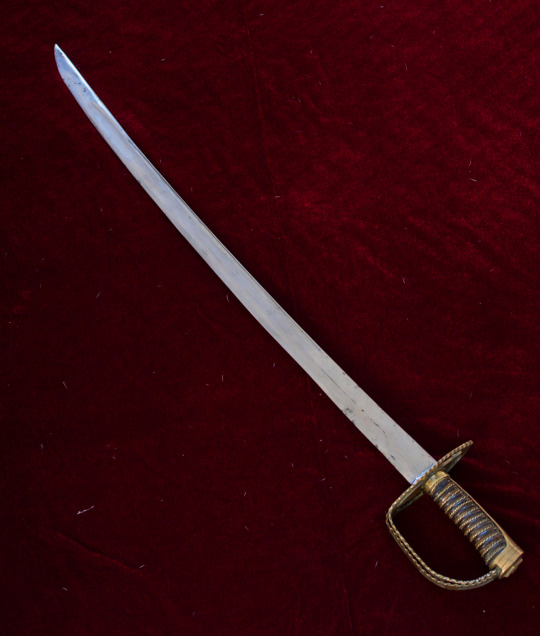
This style of guard became popular in France around 1784 and remained fashionable until about 1800. For a short period the English also followed this trend and they can occassionally be found on 1788 Pattern light cavalry officer swords or 1786 regulation infantry officers swords. But the style faded out with the introduction of the 1796 Patterns. Interestingly Austria actually adopted the rotating guard into their regulation patterns and there it remained in use until the middle of the 19th Century.
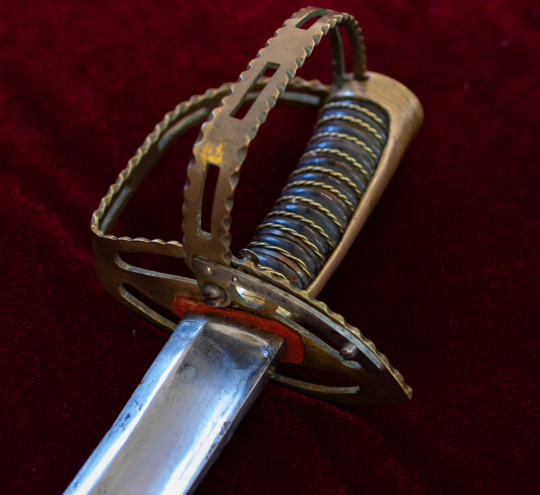
This example has a single side guard that folds out to the outside of the grip that has been scalloped along the edge with a decorative feature that is frequently seen on these swords.

The short blade length and the single frog stud on the scabbard chape mark this as having belonged to an infantry officer of a lower rank who still marched with his men.
Stats:
Overall Length - 765 mm
Blade Length - 740 mm
Curve - 14 mm
Point of Balance - 110 mm
Grip Length - 125 mm
Inside Grip Length - 105 mm
Weight - 610 grams
#sword#sabre#rotating guard#French military#antiques#military antiques#18th Century#napoleonic wars#French swords#Sabre a Garde Tournante
34 notes
·
View notes
Text



French 'Sabre a l'Orientale' cavalry officers' sword
The 'Sabre a l'Orientale' (often called mameluke swords in English) gained popularity with fashionable officers during the French campaign in Egypt and Syria (1798 to 1801).
Initially, these swords would have been acquired in battle either as a trophy, from being given as a token of respect by allies, or from a surrendering foe.
However, as the fashion spread throughout Europe, local sword makers and cutlers began to produce their own interpretations of the style, such as the regulation dress sabres of British Lancers.
This sword style remains in service today as the British 1831 Pattern General Officers sword and US Marine Corps Officer dress sword.

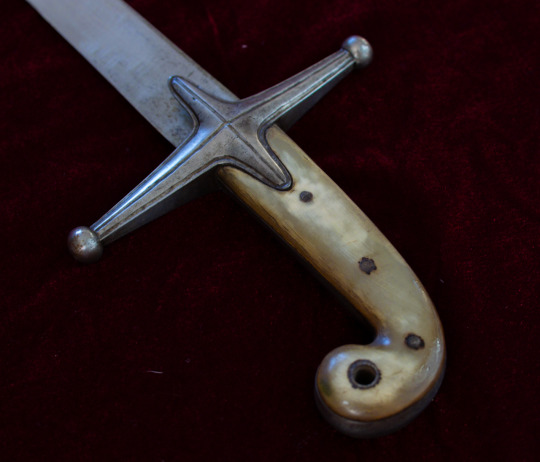
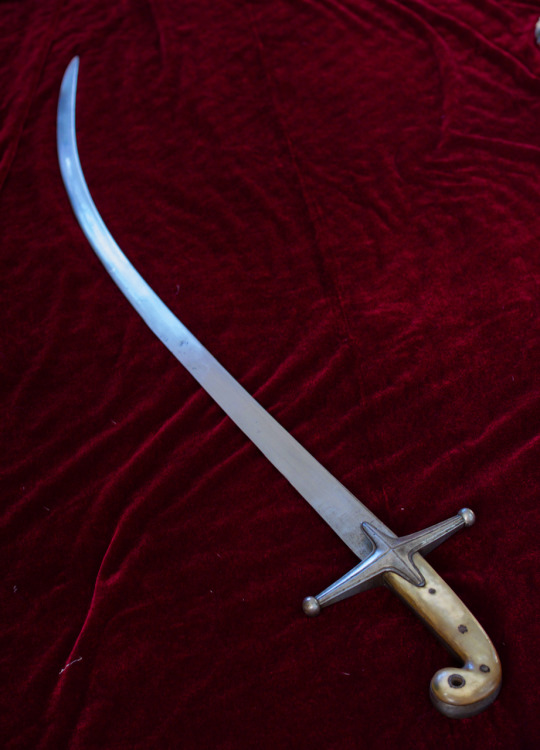
My sword likely dates from 1810 to 1830 and caught my interest because it features an Eastern-produced shamshir blade mounted in a European-made mameluke-style hilt with cow or buffalo horn grip scales. The sword is plain and functional without the ornamentation typically found on swords belonging to senior officers. Going by the style of scabbard drag, this sword originally belonged to a French cavalry officer.

Stats:
Overall Length - 950 mm
Blade Length - 805 mm
Curve - 75 mm
Point of Balance - 1730 mm
Grip Length - 125 mm
Inside Grip Length - 94 mm
Weight - 920 grams
#sabre#sword#sabres#swords#antiques#military antiques#French swords#Mameluke#napoleonic wars#mamaluke sabre#Sabre a l'orientale
90 notes
·
View notes
Text
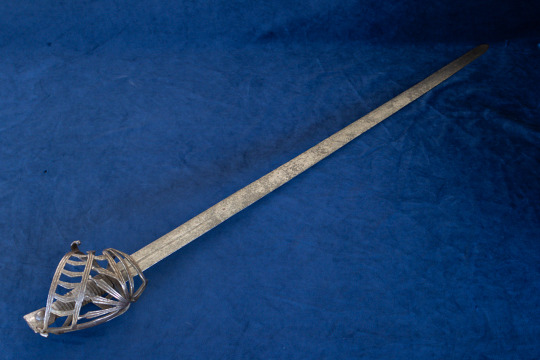
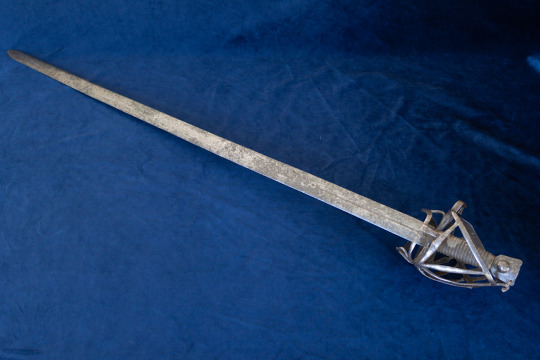
Early 18th Century Venetian 'Schiavona' Sword
The Schiavona is an iconic basket-hilted sword that was closely associated with the Italian city state of Venice. The earliest examples are believed to have come from an elite body of Slavic soldiers hired by the Venetian council, and date back as far as the late 16th Century.

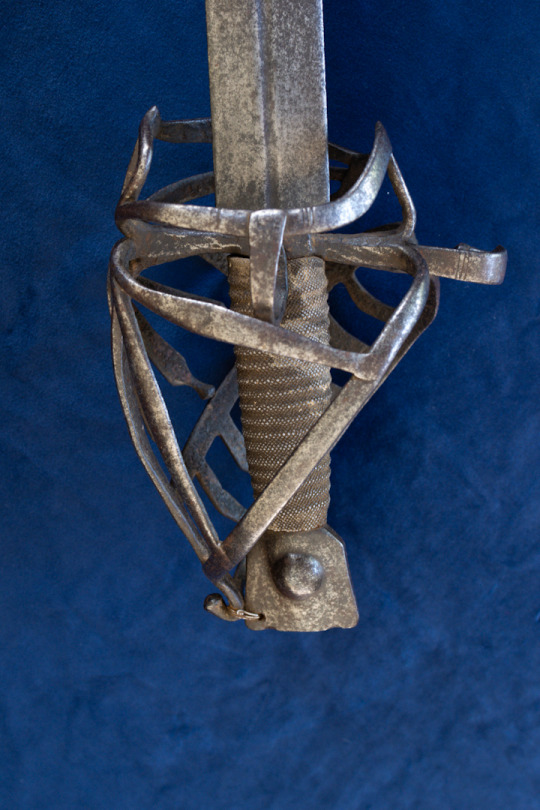
Schiavona are identified by their unique basket hilts and 'cats head' pommels. The renowned sword historian and author, Ewart Oakeshott grouped the schiavona basket hilts into two broad categories, the simplified Type 1 with it's broad flat bars, and the Type 2 of lattice work design.
They Type 1 hilt began to appear around the early 1600's and the first Type 2 between 1620 and 1630. Type 1's remained in use for most of the 17th Century after which Type 2 hilts became dominant.
Over the life of schiavona swords, (1600 - 1797) their hilts became increasingly complex and ornate as they became associated with the character of Venice, with the upper levels of society also carrying their own schiavonas.



Based on the features of the hilt, this sword most likely dates to 1710 - 1740. The iron pommel and 93 cm blade suggest that it is of munitions grade and was likely carried by a regular cavalry man.
Stats:
Overall Length - 1,075 mm
Blade Length - 930 mm
Point of Balance - 165 mm
Grip Length - 135 mm
Inside Grip Length - 94 mm
Weight - 1,090 grams
#swords#antique swords#military antiques#Italian#City of Venice#Cavalry swords#Schiavona#18th Century#Broadsword#basket hilt#Italian Basket Hilt
238 notes
·
View notes
Text
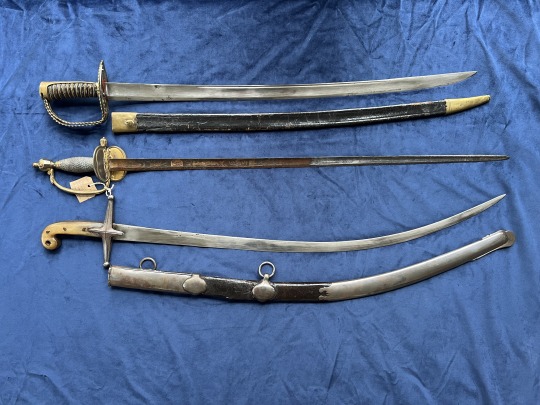
New sword day
Always a pleasure to come home to a parcel containing swords.
Top to bottom they are:
French infantry officers Sabre' à Garde Tournante circa 1780 -1800.
British 1796 pattern infantry officers' sword (co-shipped for a friend).
French cavalry officers' Sabre à l'Orientale circa 1810 - 1830.
#french swords#swords#sabres#saber#mameluke#Sabre à l'Orientale#Sabre' à Garde Tournante#British Swords#1796 Pattern infantry officers' sword#napoleonic wars#military antiques#antiques
43 notes
·
View notes
Text

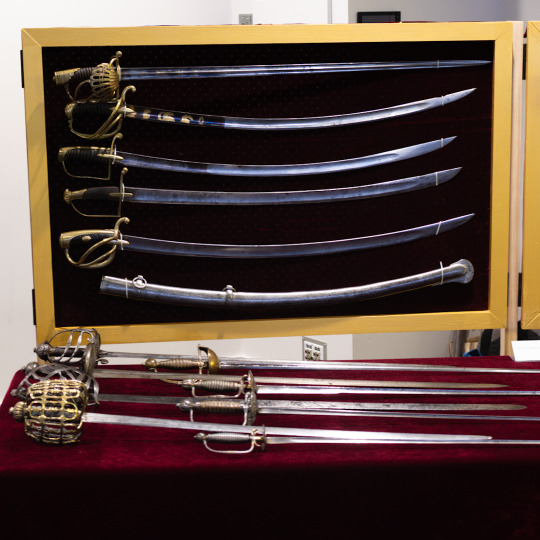
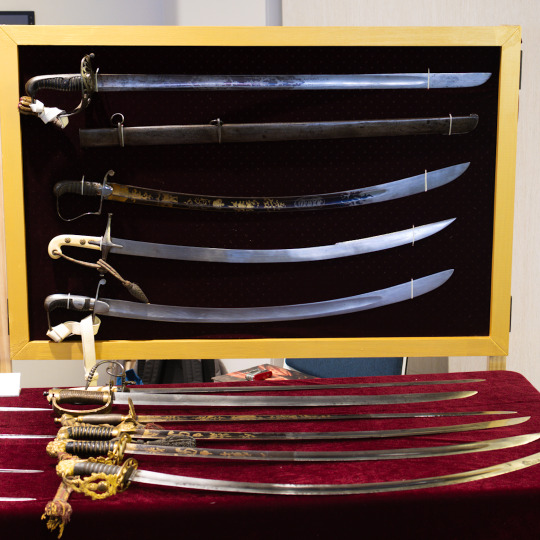
Photos of the sword display I had at last weekends excellent Auckland Blade and Knife show.
Was great to see meet with New Zealand's very talented knife makers showing off their work. Truly inspiring works of art.
For my display I opted to have a selection from the collection that covered a broad range instead of focusing on the one topic.


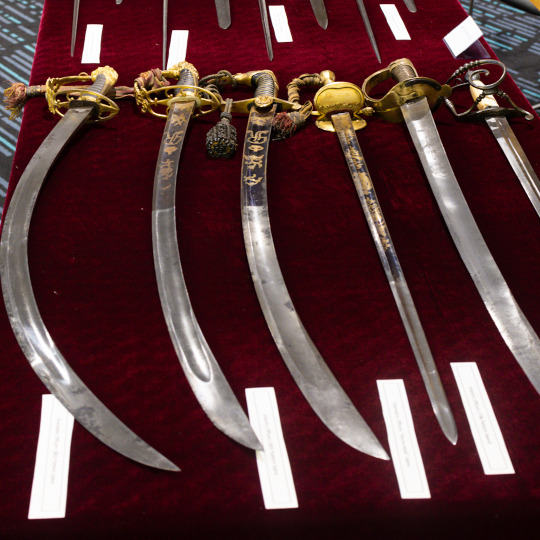
It was also my first use of the new boards I made after the last show. These are on their own stands giving me more table space.
Despite being a bit rough about the edges (remember folks, measure twice, cut once 🤣) they worked well. The next challenge is to improve on how the swords are mounted. Cable ties work great, but they're fiddly to pass through the cloth backing while trying to hold up a sword at the same time.
My thanks to The Auckland Blade Show for organising such a great event and for allowing me to participate. Shows like these are key to showing people just what is available and possible.
#swords#antiques#napoleonic wars#military antiques#british army#sabre#cavalry#Shows#Displays#Walloon Sword#Schiavona#Smallsword#Baskethilt#Spadroon
139 notes
·
View notes
Text
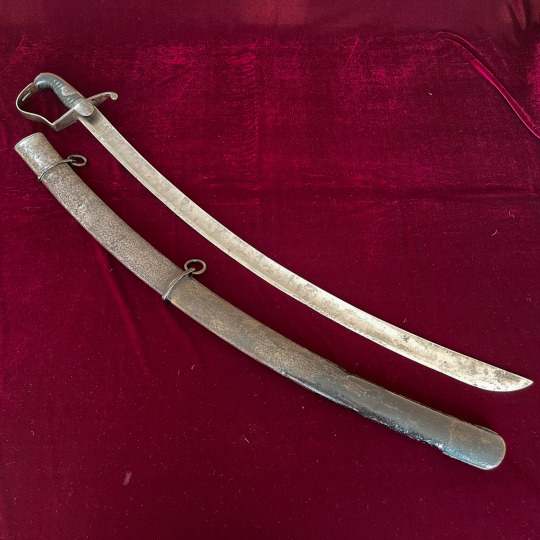


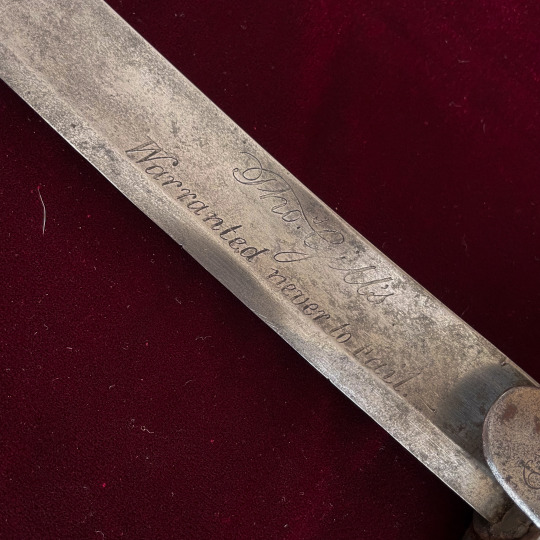

1796 Pattern light cavalry troopers sabre by Thomas Gill, circa 1796 - 1801.
#Sabre#1796 Pattern#1796 Pattern Light Cavalry#British Cavalry#Yeomanry#british army#napoleonic wars#military antiques#swords#antiques#light cavalry#cavalry
111 notes
·
View notes
Text

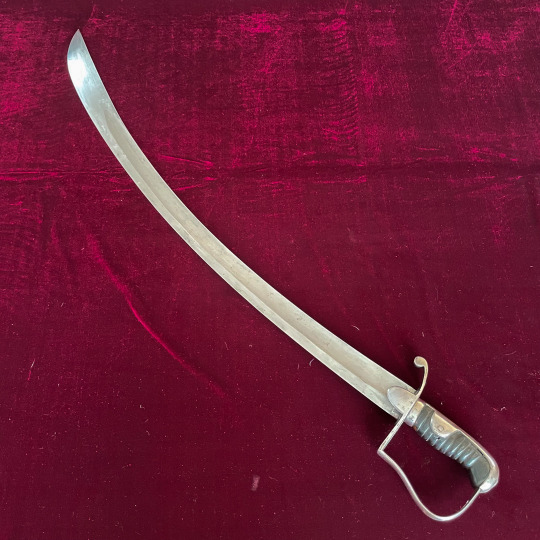
Dutch m1813 No.1 light cavalry troopers sabre.
While initially supplied with English made 1796 Pattern light cavalry sabres in the late months of 1813, the Dutch Army procured a further 3,800 sabres from different Solingen manufacturers between 1814 and 1819.
The m1813 No. had a long service life, being issued to the Light Dragoons, Hussars, Lancers and the East Indian Cavalry. Even when it was replaced in 1829 with the No.3 light cavalry sabre, many were re-issued to the 'Jagers te Paard' and second line units.
They likely remained in service until the late 1830s early '40s when the remaining stocks were inspected and put into storage at the Artillery depot in Brielle. In 1880 hundreds of out of service swords were transferred to the Rijksmuseum and put on display in the Waterloo hall.
While there are visual differences between the Prussian m1811 Blucher sabre, itself a copy of the 1796 Pattern, the Solingen produced m1813 No.1's are visually identical to British made sabres, and can only be identified by their Dutch control stamps and the absence of British ones.
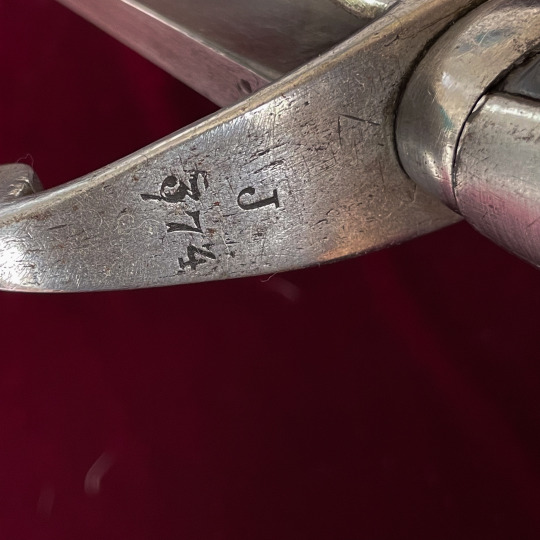

This sabre was one of the swords re-issued to the Jagers te Paard (hunters on horse) as can be seen by the serial number on the quillon which appears to have over-stamped an earlier mark. The blade is dated 1833 on the ricasso and the spine has an *L inspectors stamp, probably belonging to P. Libert who, from 1831 was the controller edged weapons, until retirement in 1840.
This 1833 date likely means that the sabre was given a replacement blade supplied by an arms maker from Liege.


The Crown over V stamp belonged to A van Deventer, who was seconded in Solingen 1837-1839 then stationed at the Inspection HQ in Delft 1843-1845
The Crown over JP stamp is believed to have belonged to the Controller Jean Joseph.
The last two photos show the m1813 No.1 next to a 1796 Pattern LC made by Thomas Gill between 1796 and 1800. The Gill sword was likely a private contract for a Yeomanry troop since there are no ordnance board proof stamps on the blade.
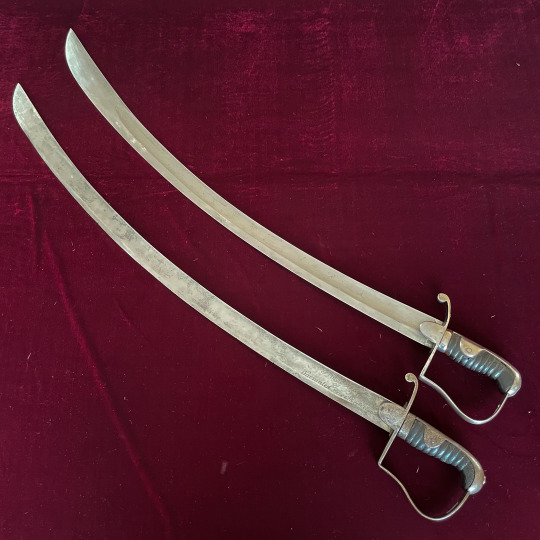

The tip of the m1813 No.1 is noticeably broader than the 1796 Pattern LC. This results in the sword having a 21 cm point of balance vs 16.5 cm on the 1796.
If you look closely at the edge of the 1796, you can see that it is slightly concave. This is evidence of damage in service that has been repaired. The chips that are also visible and commonly seen on other blades are more likely to have been caused by careless owners after they were sold out of service.
#Dutch Army#Cavalry#Light cavalry#m1813 No.1 Sabre#Sword#Sabre#Antique#Military Antiques#napoleonic wars#10 Day War#1796 Pattern Light Cavalry Sword
62 notes
·
View notes
Text


1796 Heavy cavalry troopers sword by Dawes in original configuration (although the grip leather has been replaced).
When Major John Gaspard Le Marchant, proposed his new cavalry sabre design with his system of mounted swordsmanship; his intention was for his new sabre to be the universal sabre for the British cavalry (a concept that was 60 years ahead of it's time).
And while his sword was accepted as the 1796 Pattern light cavalry sabre, the officers of the heavy cavalry insisted on a straight bladed design. Falling back on his experiences with the Austrian cavalry in the Low Countries campaign (1793-95) he suggested a sword that was an almost direct copy of their model 1769 pallasch.



While an effective cutting sword, the hatchet tip of the 1796 HC, was not suitable for thrusting and in service these were often re-profiled to have a spear tip. Other changes included removing the langets and narrowing the guard on the inside to prevent wear on the uniform while wearing.
Like it's light cavalry counterpart, the 1796 Pattern sword was also exported to Britain's allies; Portugal and Sweden during the Napoleonic wars.


#sword#back-sword#pallasch#1796 Pattern#1796 pattern heavy cavalry sword#cavalry#British Army#Georgian Era#Napoleonic wars#military antiques#heavy cavalry#John Gasapard Le Marchant
139 notes
·
View notes
Text
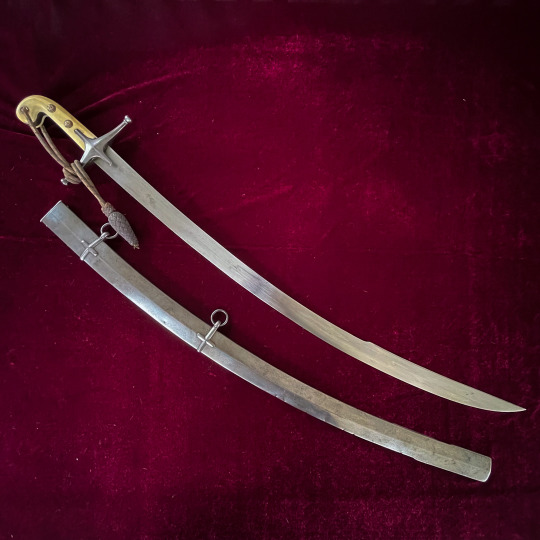

Late Georgian era British Lancers or Dragoon officers dress Mameluke sabre.
While they are called 'Mameluke' sabres by collectors, they are in truth a Europeanised interpretation of the shamshir or kilij sabres that the actual Mameluke warriors used. The 'Mameluke' sabre had become fashionable with many British (and French) officers following Napoleon's Egyptian campaign and were carried by many notable officers on both sides of the conflict, including the Duke of Wellington.
However, it was only in 1822 that the British army first officially recognised the 'Mameluke' as a regulation pattern for the newly formed lancer regiments.
In 1831 with the Pattern sword for General Officers, which remains the current dress sword for Generals in the British and many Commonwealth Armies to this day.
Mameluke sabres can also be found with links to other light cavalry and some heavy cavalry regiments, plus they were carried as bandsman's swords.


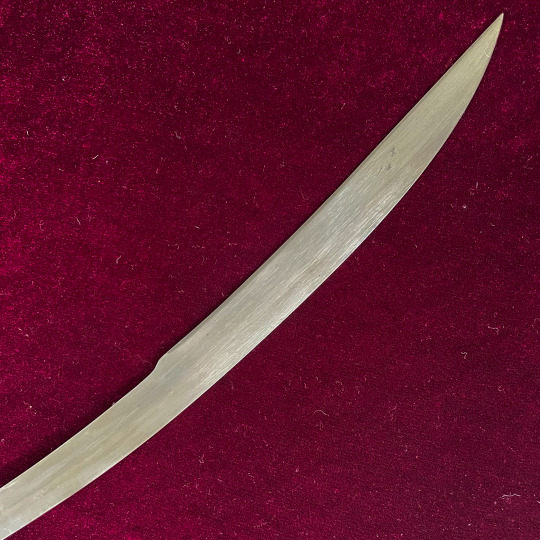
#sword#Sabre#Mameluke#Light Cavalry#Napoleonic Wars#Antiques#Antique Weapons#Military history#British Army#Lancers#Georgian Era#19th Century
102 notes
·
View notes
Text

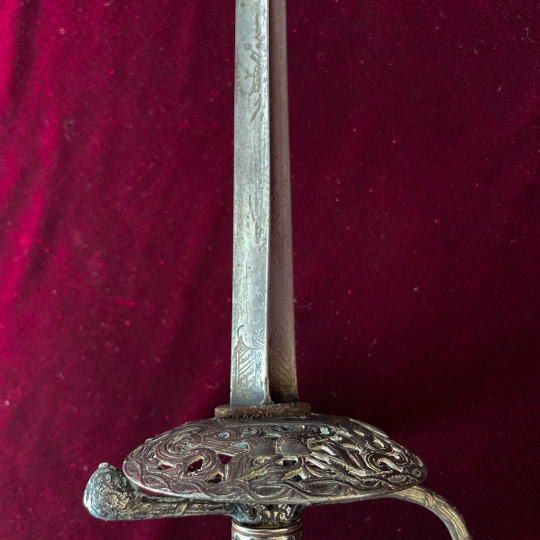
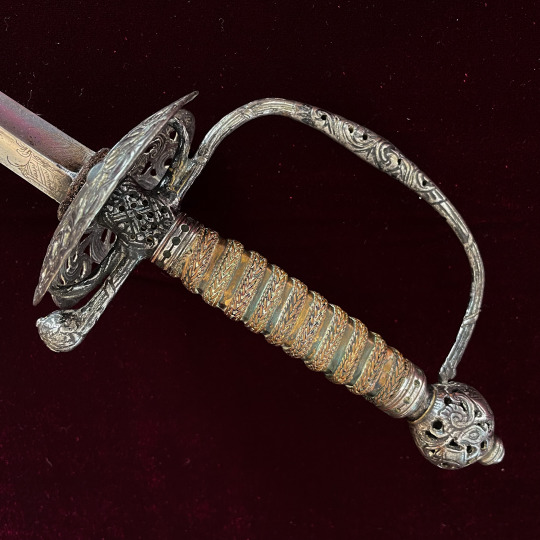
Late 18th Century European smallsword with a chased and pierced steel hilt. The guard is a symmetrical in the 'Pas d'ane' style and decorated with military trophies indicating that this might have belonged to a military officer. The grip is square and bound with alternating copper ribbon and twisted wire. Originally this would most likely been silver plated.
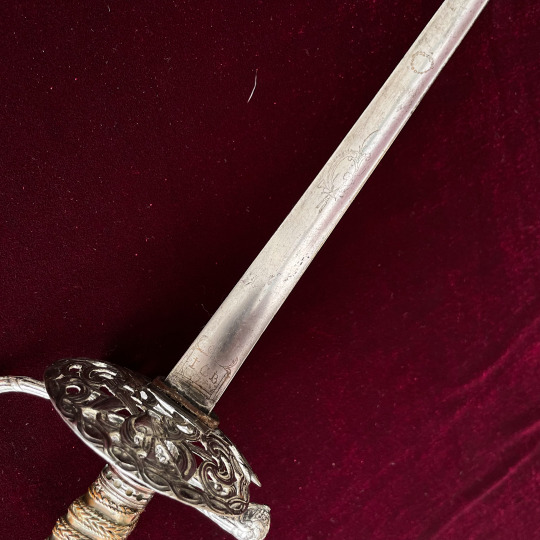
The hollow ground trefoil blade is by Johann and Clemens Boegel of Solingen and maked with their I.C.B trademark and other motifs typical of the time.
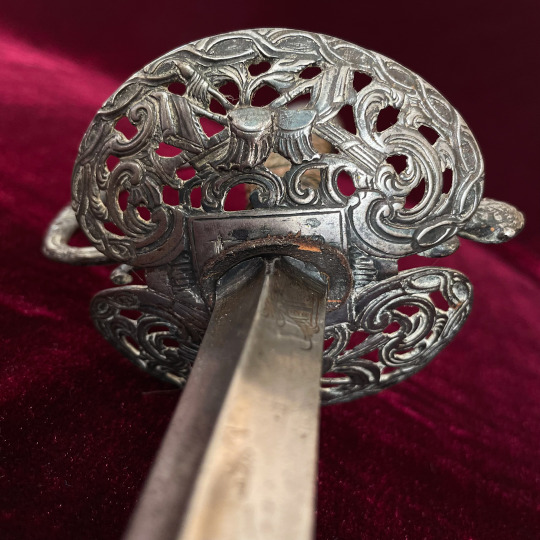
The term 'Pas d'ane' comes from French and translates as 'donkey's foot' after the shape of the donkey sole. Commentators on smallswords often misidentify the small loops between the guard and the knucklebow and quillon as the 'pas d'ane' when the correct term for them is annulets.
On Western European smallswords the annulets are a decorative hang over from earlier fencing styles when they were larger to allow the fencers' finger over the crossguard.
232 notes
·
View notes
Text

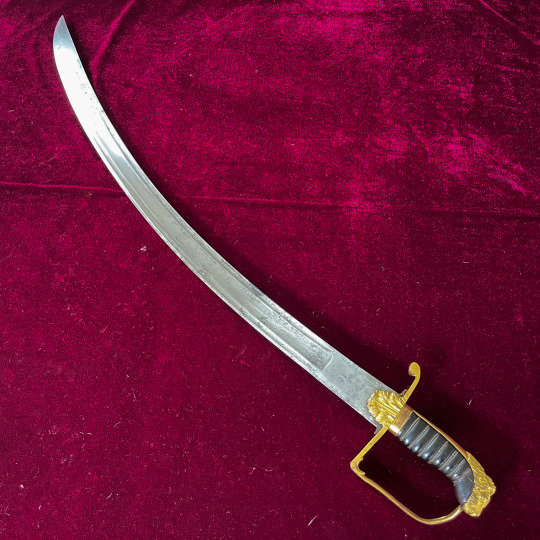
Georgian Light Cavalry Style Officers' Sabre by S. Brunn
This sword is another one of those obscure British Officer swords of the Georgian era that draw inspiration from the light cavalry style sabres. The scabbard locket is marked "BRUNN Sword Cutler to the Prince Regent 56 Caring Cross London" which dates the swords to between 1811 and 1820.
From 1800 to 1811 Brunn advertised himself with "By Appointment to H.R.H The Prince of Wales" which then changed to "The Prince Regent" from 1811 to 1820. He also changed address once, situated at 55 Caring Cross from 1799 - 1804, while his address was listed in 1805 as 56 Caring Cross.

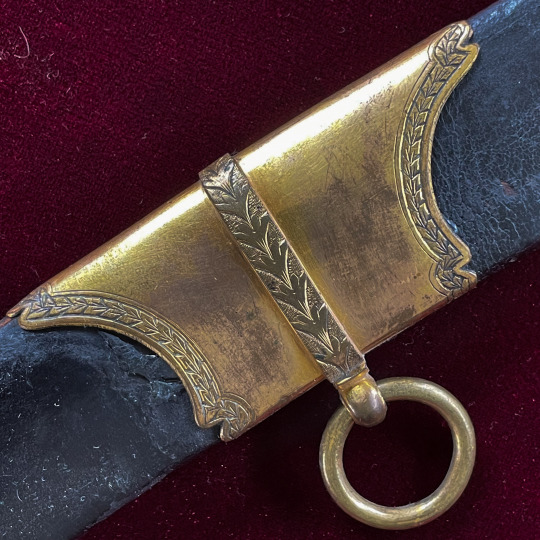

Samuel Brunn was one of the premier sword cutlers of the Georgian era, which is reflected in the workmanship of this sword. Unfortunately there are no unique identifiers on the sword to give us a clue as to who first owned it, so we can only speculate that it was a well to do gentleman that wished to retain a solid blade.
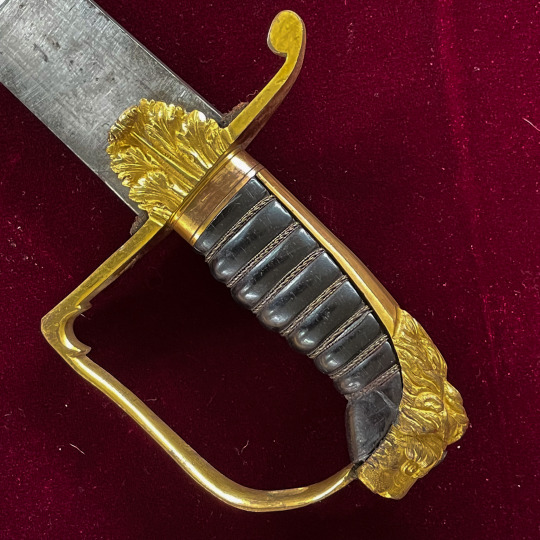
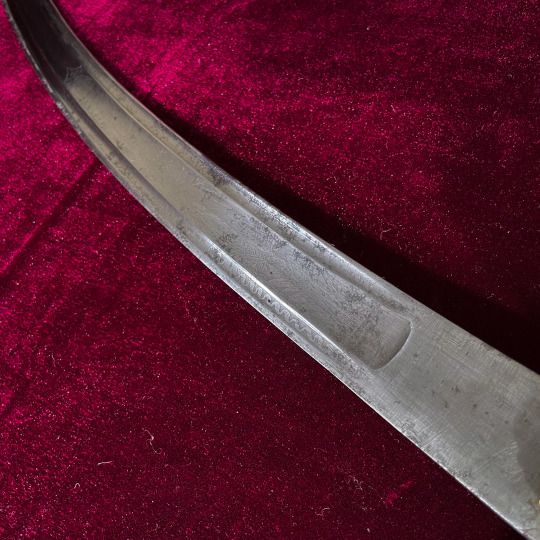
The half lions head pommel is fairly typical of infantry officers swords of the time, but again there is evidence that this style was used by Naval, Artillery and some Cavalry officers as well. And the short blade length would certainly have been more practical on a ships' deck or behind an artillery battery than on a horse. One other clue is the absence of a frog stud on the scabbard locket, meaning that this sword was only ever intended to be carried on a belt (as opposed to a sword baldric).
But as always, everything is pure speculation, there were just too many variations and quasi-military roles where it was the practice to wear a sword as part of the dress code to ever know for sure.
Stats:
Overall Length - 810 mm
Blade Length - 695 mm
Curve - 57 mm
Point of Balance - 130 mm
Grip Length - 106 mm
Inside Grip Length - 90 mm
Weight - 720 grams
#Sabre#swords#British Army#Georgian Era#Napoleonic era#military antiques#antiques#antique weapons#Militia#Samuel Brunn
94 notes
·
View notes
Text
British Lancer Officer's Full Dress Sword
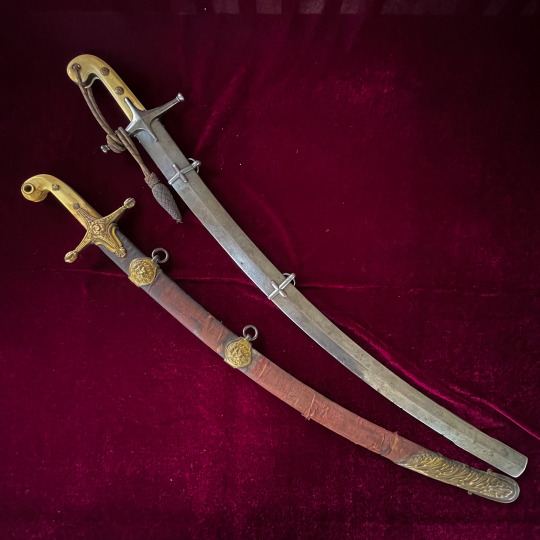

"On 25th April 1822, the first Dress Regulations for the Army (Regulations for the Dress of General, Staff, and Regimental Officers) were published by the Adjutant-General's Office and practice of carrying a 'mameluke-hilted' sword by officers of the cavalry received official sanction for the first time: the three existing lancer regiments - the 9th, 12th and 16th Lancers - were prescribed a 'mameluke-hilted' sword with a plain metal scabbard for dress wear and a velvet-covered scabbard for full dress."
- The British Cavalry Sword 1788 - 1912 by Richard Dellar, Pg 111

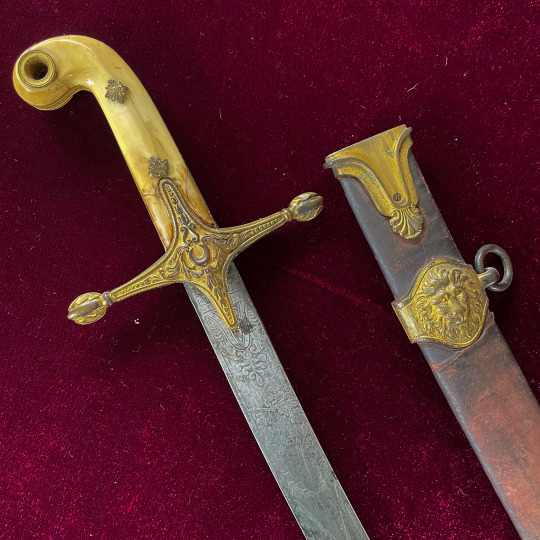
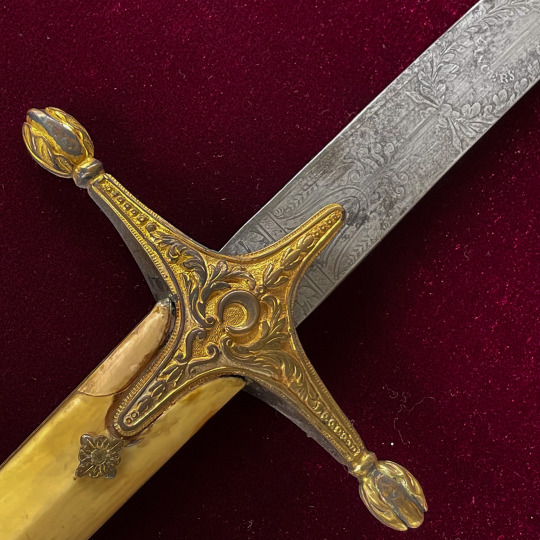
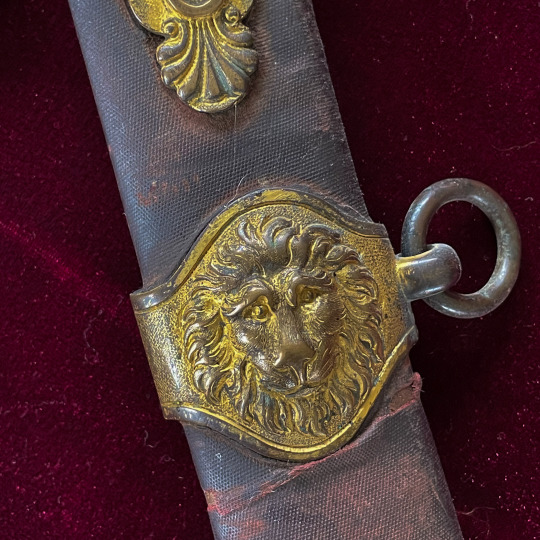

#Sabre#sword#Mameluke sabre#British Army#Cavalry#Dress swords#Antiques#Military Antiques#Lancers#Light Cavalry#Georgian Era
91 notes
·
View notes
Text

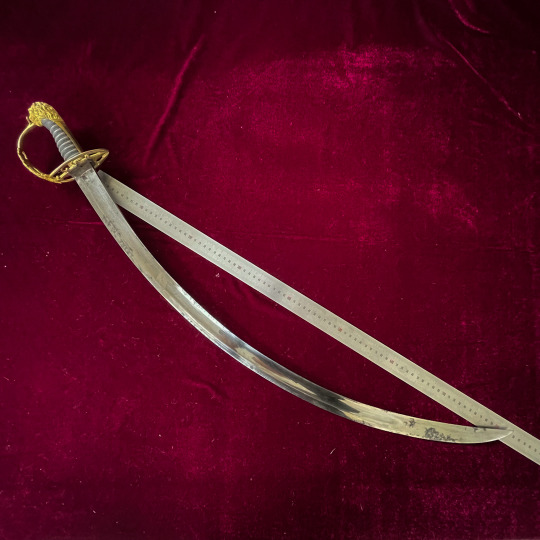
Grenadier Officers sabre in the style of the 1803 Pattern infantry officers sword.
Although I've posted this sabre to the blog previously, I took extra pictures over the weekend to upload my Instagram account, and I might as well share them here.
This is another of those fun Georgian era sabres that doesn't neatly fit into any specific pattern. While the hilt shares similarities with the 1803 Pattern, instead of having the Royal Cipher, this sword has the grenadiers' flaming bomb surrounded by a wreath. It is also has a very heavy blade that is 'fashionable' with it's extreme proportions.

With a length of 82 cm and a curvature of 11.5 cm there is a lot of steel to blade. And the weight can be felt in the 17 cm balance point making the sword heavy in the hand. Maybe the officer who commissioned it was particularly tall, or he was of sufficient rank to be mounted and wanted a sword to use from horse back. Maybe he just wanted the biggest sword he could get away with. Unfortunately we'll never know.
By comparison, the other sabre is an 1803 Pattern Infantry officers by Bennett, this sword has a 81 cm blade and 13.5 cm balance point making it a much better handling sword.



#Swords#Sabre#British Army#Infantry#Grenadiers#Infantry Officers#Antiques#Military antiques#Georgian Era#Napoleonic Era#Cross posting
109 notes
·
View notes
Text

This sabre is probably my favorite enlisted ranks swords. While the British 1796 Pattern light cavalry sabre is an iconic weapon, the Dutch m1813 No.2 light cavalry troopers sabre fells better in my hand, has a longer blade and more hand protection.
Modeled on the French An XI light cavalry sabre, which the armed forces of the newly formed Kingdom of the Netherlands would have retained in significant quantities, 1,000 of these sabres were ordered in February 1814 and another 1,000 in April 1815.
A unique Dutch design, these were originally intended for the mounted Artillery and the Artillery train. However there is evidence that these were also used by the Light Dragoons to supplement their British made 1796 Pattern light cavalry sabres, called the m1813 No.1 in Dutch service.
Both the m1813 No. 1 and No. 2 sabres were replaced by the m1814 in the middle of the 1820s although they continued to see use with secondary units well into the 1830s. The TT stamp on my example shows that for part of it's service life it was issued to the Artillery Train.
#swords#cavalry#light cavalry#Dutch Army#Napoleonic wars#sabre#m1813 No. 2#napoleonic era#military antiques#antiques
116 notes
·
View notes
Text
Planning for another show. This time the Auckland Blade and Knife Show, held in the Ellerslie Events Centre on the weekend of 23rd and 24th September.
While primarily focused on artisans (blade makers) and suppliers, I approached the organisers and asked if there was interest in a display of antique swords. Since the idea appealed to them, I’ve booked a table and now have to decide what to show.
The easy option would be to reuse my 1796 Pattern swords display.
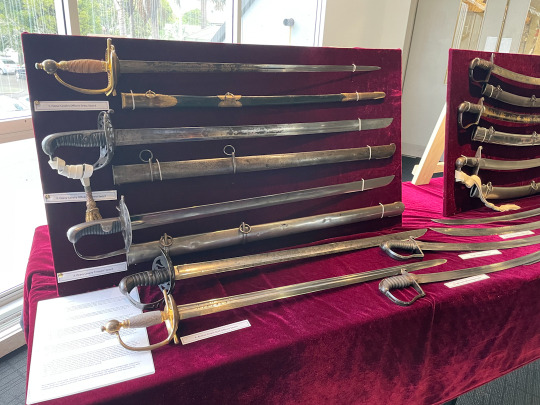
I will be using the same display boards and was also considering a 17th -18th Century theme of smallswords and broadswords.

But others have suggested that sabres would be of interest. But which sabres?
An assortment from the collection, including French, British and Dutch:
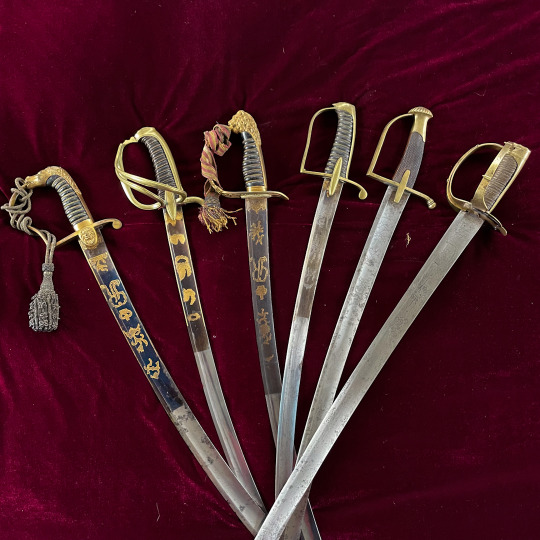
Or should I just limit them to just British ones so that people can see the variations within the patterns:

What does everyone think?
108 notes
·
View notes
Text


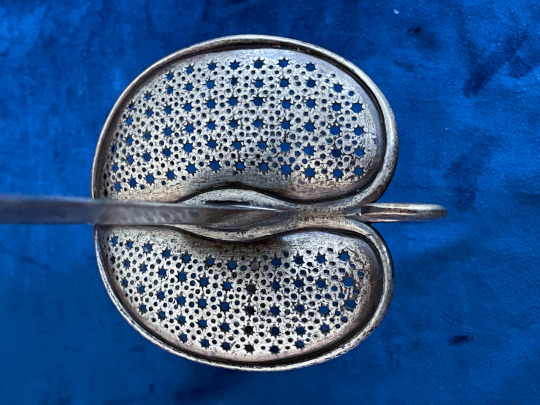

17th Century 'Walloon' Sword.
While I've shown this sword before, I've held back from making a dedicated post while I attempted to researched it further. Unfortunately, there just isn't enough information available to come to any definitive conclusions and we are left to speculate based on snippets of information and clues we find in the objects themselves.
This style of sword is typically described and the 'Amsterdam town guard sword.' And is a sub-class of the broader 'Walloon' sword.
Calling these 'Walloon swords' is another modern collectors' practice of convenience which is believed to have originated with the French cavalry sword; 'Epee Wallone' which was in service from the late 17th to the middle of the 18th Century.
Walloon swords are believed to have originated in the German states of the Holy Roman Empire during the time of the Thirty Years War. They are identified by the asymmetrical disk shaped guards, solid knuckle guard with two of more side branches. The guards can be solid and decorated with grotesque faces, animals or plant motifs, or they can be perforated. Typically they will have a thumb-ring attached on the left underside of the guard. Blades can be either double or single edged.
The 'Amsterdam' Walloon sword, named because of the Amsterdam Coat of Arms invariably found stamped into the ricasso, is a very distinct sub-type that features a perforated asymmetrical disk guard decorated with pierced suns surrounded by moons. It is finished by a short upturned rear quillon. They have a single knuckle bow which is fixed to the ball pommel by a screw and a thumb-ring on the left side that extends out to the edge of the guard. The grip is wrapped with wire and finished at both ends with a 'Turks head' knot. The blades are long, double edged with a single fuller at the base. They are invariably stamped with triple Xs under a crown Coat of Arms for Amsterdam. The surviving examples are very uniform for this period in time, making it is possible that this was the first European pattern sword produced.
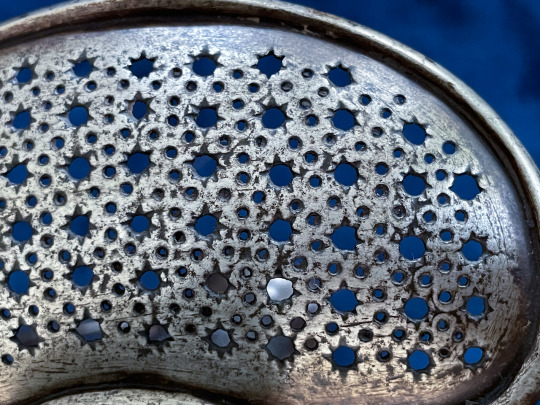

While the link to Amsterdam is clear in the markings, it is unlikely that this type of sword was issued to the cities guard or militia. The number of surviving examples indicate that these were made in too large quantities to have been issued to a small localised force.
During the 17th Century, The Netherlands was a republic of seven provinces. And rather than a standing national army, each province would have supplied and maintained their own levies in times of war. One possibility is that these swords were supplied to the cavalry of the Province of Holland, of which Amsterdam was the economic capital.
Another theory is that the French experience of 'Walloon' swords, encountered during their war with the Dutch in 1672 to 1673. Dissatisfied with their current cavalry swords, French King Louis XIV ordered that his cavalry be equipped with a new sword of the 'Walloon' type. This is discussed in an article in the French magazine Gazette des Armes.
However that doesn't explain the presence of the Amsterdam Coat of Arms on these swords. Then again, Amsterdam was a major mercantile center for Europe, and it is possible that the French order was brokered by Dutch merchants who placed their mark on the blades when they arrived from Solingen.
It should also be noted that the Amsterdam mark is often accompanied by the Solingen blade smiths' own mark. On this sword the makers mark is mostly obscured by the guard, but you can just make out the top of a crown at the ricasso (the horizontal stamp is another verson of the Dutch markings).
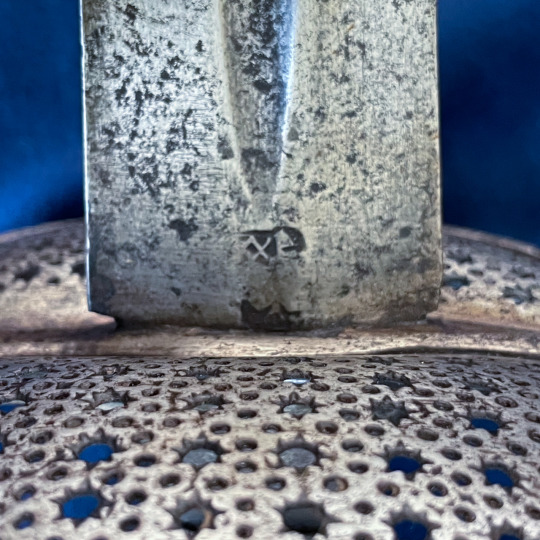
In the hand, this is a beast of a sword, the grip and guard are large to accommodate gloves and the blade is very long, suitable for fighting from horseback. But despite its' proportions, it is not a heavy or unwieldy sword.
Stats:
Overall Length - 1,080 mm
Blade Length - 920 mm
Point of Balance - 120 mm
Grip Length - 145 mm
Inside Grip Length - 120 mm
Weight - 990 grams
181 notes
·
View notes
Text
youtube
More video practice. Need to work on speaking more clearly with a bit more volume. Unfortunately the editing software I use won't let me lower the volume of the background clip further.
#antiques#swords#british army#napoleonic wars#military antiques#light cavalry#sabres#1796 pattern#Yeomanry#Youtube
14 notes
·
View notes